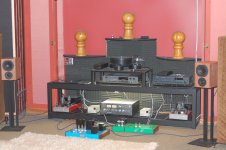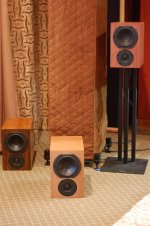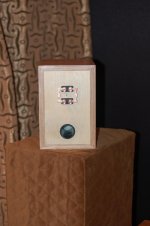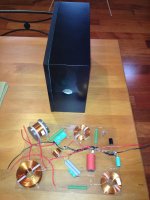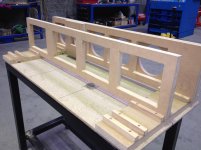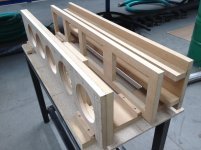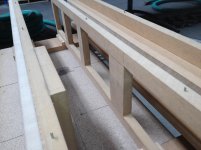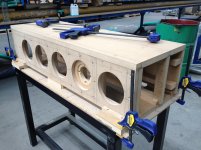Are you a dog person?
OK, here goes.
The Nomex only needs one of the LCRs, so omit 2.2uF/0.12mH/1R5 (C13, L14 and R15).
Hello Joe. I have the nomex in hand..
Do I leave out (C13,L14 and R15) Values for these are 2.2uf/.33hm/2R5
Thanks, Joel
Hello Joe,
I am new to this forum but I am in the process of building the xover for the JRMini (Nomex version). In your previous post, it stated to omit C13, L14 and R15 but they are valued at 2.2uf/0.33mh/2R5 instead of 2.2uf/0.12mh/1R5. I am a bit confused. Should I omit (C13, L14 and R15) or (C9, L10 and R11). Any help would be appreciated.
Thanks,
Gene
I am new to this forum but I am in the process of building the xover for the JRMini (Nomex version). In your previous post, it stated to omit C13, L14 and R15 but they are valued at 2.2uf/0.33mh/2R5 instead of 2.2uf/0.12mh/1R5. I am a bit confused. Should I omit (C13, L14 and R15) or (C9, L10 and R11). Any help would be appreciated.
Thanks,
Gene
Are you a dog person?
OK, here goes.
The Nomex only needs one of the LCRs, so omit 2.2uF/0.12mH/1R5 (C13, L14 and R15).
So that's a good start getting rid of three components. The Nomex has a smoother roll-off above the crossover and that is why it isn't needed.
Because the Nomex cone is lighter, the tonal balance will be affected. But due to the same motor and cone profile has a similar response shape, this is why we should be able to get away with it. Normally I would prefer to computer model it, but knowing both of these drivers well - we can get away with it, but you need to do a little work yourself... read on....
The Tweeter's output needs to be increased slightly. The R16 should be decreased in value, I would suggest trying 4R. The other component is the main series cap C0 - it may be worth adding a 0.33uF in parallel (bumping up the value slightly) to 4.3uF approx.
These two values should be adjusted by ear, but only changed by the minimum amount that you can get away with. Indeed listen to it with the previous values first and see if you find the Tweter's output a little dull. If so, then decrease R16 and increase C0 by ear.
That's it. Let me know how it goes.
Cheers, Joe R.
Hello Joe. I have the nomex in hand..
Do I leave out (C13,L14 and R15) Values for these are 2.2uf/.33hm/2R5
Thanks, Joel
Hi Joel
Had to take another look, hope I haven't mislead anybody.
There is an extra and higher frequency LCR compensation that the Nomex can omit, so which one is it?
It is the higher frequency one and determined by "L" and "C".
They both have the same "C" value - so that is no indicator, but the "L" values are different - the "R" value does not affect frequency.
The smaller "L" value defines the higher frequency LCR and is 0.33/0.12 higher Octave frequency. So one is 2.75x higher in frequency.
So, here for sure:
OMIT:
C9 2.2uF
L10 0.12mH
R11 1.5R
KEEP:
C13 2.2uF
L14 0.33mH
R15 2.5R
That is definitive.
I would still try tuning the main series cap C0 to the Tweeter by ear.
Cheers, Joe R.
Last edited:
Hi Joel
Had to take another look, hope I haven't mislead anybody.
There is an extra and higher frequency LCR compensation that the Nomex can omit, so which one is it?
It is the higher frequency one and determined by "L" and "C".
They both have the same "C" value - so that is no indicator, but the "L" values are different - the "R" value does not affect frequency.
The smaller "L" value defines the higher frequency LCR and is 0.33/0.12 higher Octave frequency. So one is 2.75x higher in frequency.
So, here for sure:
OMIT:
C9 2.2uF
L10 0.12mH
R11 1.5R
KEEP:
C13 2.2uF
L14 0.33mH
R15 2.5R
That is definitive.
I would still try tuning the main series cap C0 to the Tweeter by ear.
Cheers, Joe R.
Perfect! Thanks Joe
Also I will subtract the DCR of L14 from 2.5R to get the real value of R15
Joel
JR Mini comparison to JR Mini and JR mini 
Member BrotherGene taking part tuning crossover with a variety parts selection with listening comparison
1)Poly with all Solen Parts
2)Poly with Mundorf silver cap for C0
3)Nomex with solen. C0 is 4.3uf and 4R3 for tweeter
All 3 Mini's sound amazing with bass that handles kick drum womps without sounding weak.. Driver Intergration seems perfect. Soundstage is holographic. Intstruments in right size proportion and placed in space..
The Nomex wins for speed and detail and clearer overall but without this comparison the poly clearly beats out speakers over $2k that I have heard..
Mundorf cap increases treble detail and air and tweeter seems louder.. We liked the sound of silver cap but skews balance off a little as woofer need to come up to tweeter level..
More parts swaps to come..
Also Play with port lenght and stuffing..

Member BrotherGene taking part tuning crossover with a variety parts selection with listening comparison
1)Poly with all Solen Parts
2)Poly with Mundorf silver cap for C0
3)Nomex with solen. C0 is 4.3uf and 4R3 for tweeter
All 3 Mini's sound amazing with bass that handles kick drum womps without sounding weak.. Driver Intergration seems perfect. Soundstage is holographic. Intstruments in right size proportion and placed in space..
The Nomex wins for speed and detail and clearer overall but without this comparison the poly clearly beats out speakers over $2k that I have heard..
Mundorf cap increases treble detail and air and tweeter seems louder.. We liked the sound of silver cap but skews balance off a little as woofer need to come up to tweeter level..
More parts swaps to come..
Also Play with port lenght and stuffing..
Attachments
Progress
Progress update. Appreciate all your help fellow Elsinorians. For my first venture into speaker building i am happy. If i can be of any assistance to other novice builders, let me know.
Progress update. Appreciate all your help fellow Elsinorians. For my first venture into speaker building i am happy. If i can be of any assistance to other novice builders, let me know.
Attachments
Hi kingfisher
I think the answer is in this two posts :
http://www.diyaudio.com/forums/multi-way/97043-elsinore-project-thread-127.html#post3135660
http://www.diyaudio.com/forums/multi-way/97043-elsinore-project-thread-128.html#post3137048
I think the answer is in this two posts :
http://www.diyaudio.com/forums/multi-way/97043-elsinore-project-thread-127.html#post3135660
http://www.diyaudio.com/forums/multi-way/97043-elsinore-project-thread-128.html#post3137048
Old is new
Thanks Pascal, it has come to a matter of when and at what price I will build these speakers. I have been stalling for some time and between full time job and part time hobby, I waited for best scenario. Well since I am so delinquent with update improvements I will build pre-Bolser mod and enjoy as-is. From previous feedback it is STILL far better than what I can afford retail!
kingfisher
Thanks Pascal, it has come to a matter of when and at what price I will build these speakers. I have been stalling for some time and between full time job and part time hobby, I waited for best scenario. Well since I am so delinquent with update improvements I will build pre-Bolser mod and enjoy as-is. From previous feedback it is STILL far better than what I can afford retail!
kingfisher
Thanks Pascal, it has come to a matter of when and at what price I will build these speakers. I have been stalling for some time and between full time job and part time hobby, I waited for best scenario. Well since I am so delinquent with update improvements I will build pre-Bolser mod and enjoy as-is. From previous feedback it is STILL far better than what I can afford retail!
kingfisher
I was at TAVES this year and felt nothing there outperformed the Elsinore..
I blame some of it for bad setup and poor sources but in the best sounding rooms never did I feel " If I had the money I would take that over the Elsinore"
Pm Sent.
Evening all,
I'm looking into a build of the Elsinore's.
Anyone know where I can get the waveguide from? I emailed the guy mentioned on CustomAnalogue, but haven't heard back yet. Is there someone else who makes them?
Cheers,
Joel.
Sorry, I didn't get that email.. Maybe try it again
I have one pair from last batch ready to go. After they're gone I would make 10 minimum.. $160/pair
Thanks, Joel
Progress update. Appreciate all your help fellow Elsinorians. For my first venture into speaker building i am happy. If i can be of any assistance to other novice builders, let me know.
Looking really nice. Brings back happy memories of my build. Where did you end up sourcing the drivers?
Thanks Irext, appreciate your help. I have enjoyed the process. More so now that i can see the end in sight. I really wanted to finish in veneer but after much deliberating have decided to paint. Maybe veneer my next pair. ( if Joe lets me !)
Found all the drivers here in Ausi, mostly WES.
Found all the drivers here in Ausi, mostly WES.
chamfered edges
Another pair of Elsinore slowly coming to life here. Thanks Joe for sharing your design and Joel for your great contribution here, I would not have started this project if I had to do my own waveguide...
I have a question about the effective width of a speaker depending of baffle edge geometry. I’m using laminated hardwood for the sides, top and bottom of my Elsinore (all center pieces are done with Birch plywood) but the thickness of these panels are 33 mm instead of 25 mm and I am not very hot about weaken them by reducing the thickness to 25 mm in a wood planer.
So I would like to chamfer the edges in order to reduce the overall width of the speaker to the original dimension of 280 mm. Does a formula exists to calculate the effective width of a speaker with chamfered or rounded edges or I only have to do like the picture below? Thanks!
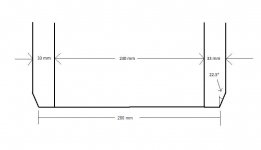
Another pair of Elsinore slowly coming to life here. Thanks Joe for sharing your design and Joel for your great contribution here, I would not have started this project if I had to do my own waveguide...
I have a question about the effective width of a speaker depending of baffle edge geometry. I’m using laminated hardwood for the sides, top and bottom of my Elsinore (all center pieces are done with Birch plywood) but the thickness of these panels are 33 mm instead of 25 mm and I am not very hot about weaken them by reducing the thickness to 25 mm in a wood planer.
So I would like to chamfer the edges in order to reduce the overall width of the speaker to the original dimension of 280 mm. Does a formula exists to calculate the effective width of a speaker with chamfered or rounded edges or I only have to do like the picture below? Thanks!

Thanks Irext, appreciate your help. I have enjoyed the process. More so now that i can see the end in sight. I really wanted to finish in veneer but after much deliberating have decided to paint. Maybe veneer my next pair. ( if Joe lets me !)
Found all the drivers here in Ausi, mostly WES.
I veneered mine in Tassie Blackwood veneer having never done it before and I am quite happy with the results. I used the second cabinet as a press to adhere the veneer to the one being worked on and used ratchet straps to clamp the cabinets together while the glue dried. A router with a flush bit was used to trim the edges. There are some pics in previous posts some months ago if you are interested. Don,t be put off trying it. When I read other peoples posts on veneering I very nearly gave up as they all gave dire warnings on failure but I,m glad I stuck with it as I do love the grain and texture of a natural timber finish. At this point I haven,t heard any speakers I like better or even as much so I think you are in for a treat.
So I would like to chamfer the edges in order to reduce the overall width of the speaker to the original dimension of 280 mm. Does a formula exists to calculate the effective width of a speaker with chamfered or rounded edges or I only have to do like the picture below? Thanks!
View attachment 313513
At the angle shown in the diagram, I don't think that should be a problem.
Thanks for the kind words.
I have been reading up lately on the modern philosophy of self-interest (seems to come up as a 'positive' when the topic of economy comes up - along the lines that "greed is good" a la Milton Friedman), and I am happy to be old fashioned on that score.
Cheers, Joe R.
Damping
Any thoughts on what i'm about to do regards damping would be appreciated.
I have got a product called "Rams Acoustic Insulation" which is a blend of 65% wool 35% polyester. 90mm thick. R2.0
Not exactly Joes spec of R3.0 75mm but not far off.
Do you think i should put it in as is, or peel a bit of to bring it back to 75mm?
It is constructed in layers and it would be easy to peel off 15mm to bring it back to 75mm . Trouble is that would reduce the R rating even more.
Cheers
Any thoughts on what i'm about to do regards damping would be appreciated.
I have got a product called "Rams Acoustic Insulation" which is a blend of 65% wool 35% polyester. 90mm thick. R2.0
Not exactly Joes spec of R3.0 75mm but not far off.
Do you think i should put it in as is, or peel a bit of to bring it back to 75mm?
It is constructed in layers and it would be easy to peel off 15mm to bring it back to 75mm . Trouble is that would reduce the R rating even more.
Cheers
- Home
- Loudspeakers
- Multi-Way
- The "Elsinore Project" Thread
